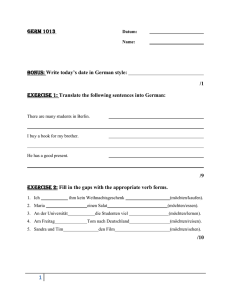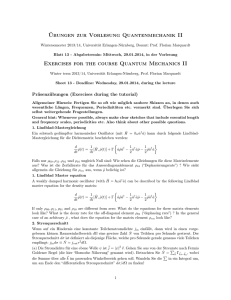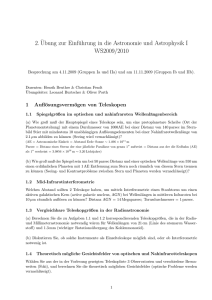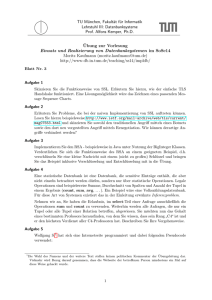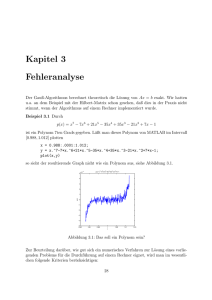13th sheet
Werbung
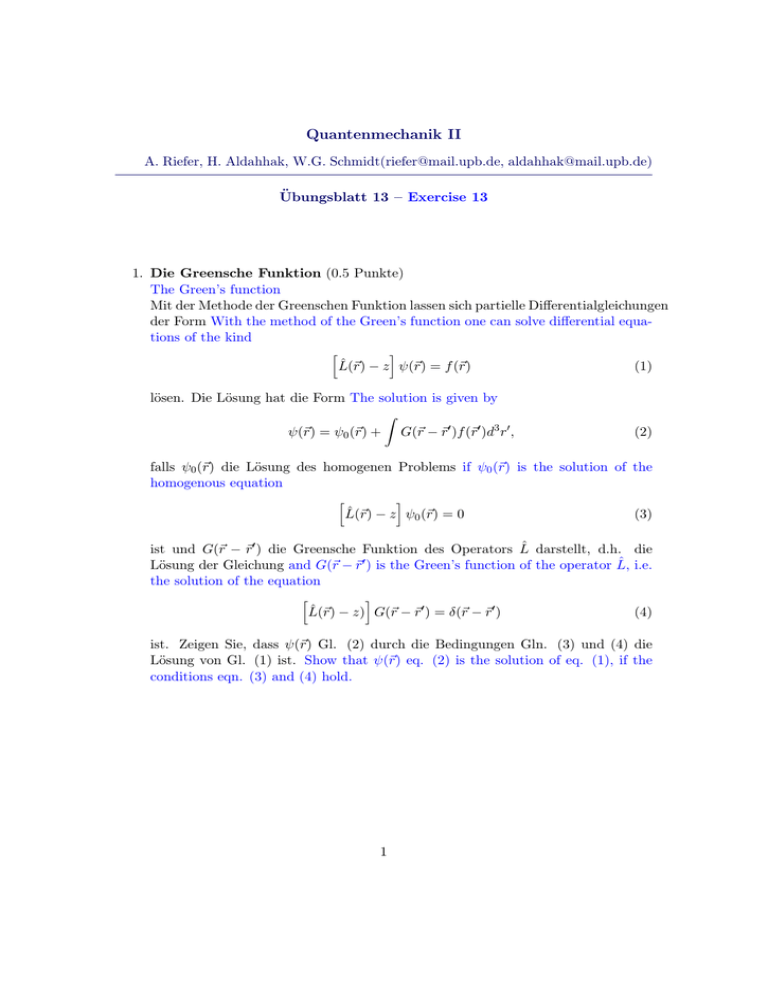
Quantenmechanik II A. Riefer, H. Aldahhak, W.G. Schmidt([email protected], [email protected]) Übungsblatt 13 – Exercise 13 1. Die Greensche Funktion (0.5 Punkte) The Green’s function Mit der Methode der Greenschen Funktion lassen sich partielle Differentialgleichungen der Form With the method of the Green’s function one can solve differential equations of the kind h i L̂(~r) − z ψ(~r) = f (~r) (1) lösen. Die Lösung hat die Form The solution is given by Z ψ(~r) = ψ0 (~r) + G(~r − ~r0 )f (~r0 )d3 r0 , (2) falls ψ0 (~r) die Lösung des homogenen Problems if ψ0 (~r) is the solution of the homogenous equation h i L̂(~r) − z ψ0 (~r) = 0 (3) ist und G(~r − ~r0 ) die Greensche Funktion des Operators L̂ darstellt, d.h. die Lösung der Gleichung and G(~r − ~r0 ) is the Green’s function of the operator L̂, i.e. the solution of the equation h i L̂(~r) − z) G(~r − ~r0 ) = δ(~r − ~r0 ) (4) ist. Zeigen Sie, dass ψ(~r) Gl. (2) durch die Bedingungen Gln. (3) und (4) die Lösung von Gl. (1) ist. Show that ψ(~r) eq. (2) is the solution of eq. (1), if the conditions eqn. (3) and (4) hold. 1 2. Poisson-Gleichung (3 Punkte) Poisson equation Lösen Sie die Poisson-Gleichung Solve the Poisson equation ∆φ(~r) = − ρ(~r) . 0 (5) Hinweise: Setzen Sie Fouriertransformation ein, um die k-Raum Darstellung der Greenschen Funktion G(~k) zu erhalten. Sie bekommen nach der Fouriertransformation von Gl. (5) eine algebraische Gleichung für G(~k). Über die Rücktransformation kann G(~r − ~r0 ) bestimmt werden. Bei der k-Raum Integration ist es hilfreich Kugelkoordinaten und den Kosinussatz zu verwenden. Hints: Use Fourier-transformation to obtain an expression for the k-space Green’s function G(~k). After the Fourier-transformation of eq. (5) one obtains an algebraic equation for G(~k). Applying the back transformation G(~r −~r0 ) can be determined. It is helpful to use spherical coordinates and the cosine rule to perform the k-space integration. Sie können verwenden: You can use: Z ∞ sin(k) 1 dk = π. (6) k 2 0 3. Greensche Funktion vs Propagator (3 Punkte) Green’s function vs propagator Die zeitabhängige Greensche Funktion des Hamilton-Operators HF eines freien Teilchens lässt sich schreiben als [vgl. Gl. (6.54) im Skript]: The time-dependent Green’s function of the Hamilton-operator HF of a free particle can be written as [cf. eq. (6.54) in the lecture notes]: Z d3 k ∗ 0 i ~ R 0 0 0 G (~r, ~r , t−t ) = −i φ (~r )φk (~r) exp − Ẽ(k)(t − t ) mit with t−t0 > 0. (2π)3 k ~ (7) φk (~r) und Ẽ(~k) = E(~k) − iδ bilden in Gl. (7) das (kontinuierliche) Spektrum der Eigenfunktionen und Eigenwerte von HF . Berechnen Sie GR (~r, ~r0 , t − t0 ) (für δ → 0) explizit und vergleichen Sie das Ergebnis mit dem Propagator eines 3-d freien Teilchens [Gl. (5.89) im Skript]. Bei der k-Raum-Integration ist es sinnvoll jede kartesiche Richtung nacheinander zu bearbeiten. Sie können die Integrale aus Übungsblatt 12 verwenden. φk (~r) und Ẽ(~k) = E(~k) − iδ in eq. (7) are the (continuous) spectrum of the eigenfunctions and eigenvalues of HF . Calculate GR (~r, ~r0 , t − t0 ) (for δ → 0) explicitly and compare the result with the propagator of a 3-d free particle [eq. (5.89) in the lecture notes]. Performing the k-space integration it is usefull to integrate the cartesian components in sequence. You can use the integrals of exercise sheet 12. 2 4. Funktionalableitungen (1.5 Punkte) Functional derivatives Es sei F : Φ → K ein Funktional. Φ ist dabei die Menge aller Funktionen φ, d.h. Φ = {φ : Kn → K}. Für K gilt: K ∈ {R, C}. Suppose F : Φ → K is a functional. Φ is, thereby, the set of all functions φ, i.e. Φ = {φ : Kn → K}. For K, it applies K ∈ {R, C} . Die Ableitung eines Funktionals ist folgendermaßen definiert: The derivation of a functional is now defined as follows: δF [ϕ] F [ϕ(x) + δ(x − x0 )] − F [ϕ(x)] = lim . (8) →0 δϕ(x0 ) Berechnen Sie die Funktionalableitungen für folgende Funktionale: Calculate the functional derivatives of the following functionals: a) F [ϕ] = ϕ(x) b) F [ϕ] = ϕ2 (x) = ϕ(x)ϕ(x) c) F [ϕ] = ϕp (x) R d) F [ϕ] = A(x)ϕ(x)dx R e) F [ϕ] = ϕ2 (x)dx 5. Thomas-Fermi-Modell (1+1+2 Punkte) Thomas-Fermi model Das Thomas-Fermi-Modell kann verwendet werden um effektive Potentiale für Selbstkonsistenz-Rechnungen zu ermitteln. Ziel dieser Aufgabe ist es, eine partielle Differentialgleichung (Thomas-Fermi-Gleichung) für das effektive Potential herzuleiten. Betrachten Sie dazu die Gesamtenergie aller Elektronen im Atom mit der Ordnungszahl Z im Rahmen des Thomas-Fermi-Modells: The Thomas-Fermi model can be applied to obtain effective potentials for self-consistent calculations. The task of this exercise is to derive a partial differential equation (Thomas-Fermi equation) for the effective potential. Therefore, consider the total energie of the electrons of an atom with the atomic number Z within the Thomas-Fermi model: Z Z Z Z e2 ρ(~r)ρ(~r0 ) ρ(~r) 2 E[ρ] = κ d3 rρ(~r)5/3 + d3 r d3 r0 − e Z d3 r (9) 0 2 |~r − ~r | r mit with κ = ~2 5/3 4/3 π 10m 3 und der Elektronen-Dichte and the electron density ρ(~r). a) Leiten Sie eine Gleichung zur Bestimmung der Grundzustandsdichte her. Derive an equation to determine the groundstate density.R Berücksichtigen Sie dabei die Nebenbedingung Incorporate the constraint d3 rρ(~r) = Z durch den Lagrangeschen Multiplikator by the Langrangian multiplier λ. b) Ausgehend vom Ergebnis aus Aufgabe (a) können Sie das effektive Potential φ definieren Based on your result of exercise (a) you can define an effective potential: Z ρ(~r0 ) Z 2 2 −e φ([ρ], ~r) := e d3 r0 − e2 + λ (10) 0 |~r − ~r | r 3 Verwenden Sie die Feldgleichung ∆φ = 4πρ(~r) (r 6= 0) um eine partielle Diffentialgleichung für φ herzuleiten. Use the field equation ∆φ = 4πρ(~r) (r 6= 0) to derive a partial differential equation for φ. c) Es folgt die Untersuchung der Randbedingungen. Now consider the boundary conditions. i. Zeigen Sie, dass Show that λ = 0 wegen because of lim ρ(~r) = 0. r→∞ (11) Sie können für den Ausdruck R 3 0 ρ(~r)You can use the monopole approximation for the expression d r |~r−~r0 | für for r → ∞ die Monopol-Näherung verwenden. ii. Das Potential φ soll sich für r → 0 wie Zr verhalten, d.h. es gilt The potential φ shall behave like Zr for r → 0, i.e.: lim rφ(~r) = Z. r→0 (12) Bestimmen Sie zusätzlich die Randbedingung für rφ(~r) für r → ∞. Determine additionally the boundary condition for rφ(~r) for r → ∞. 4
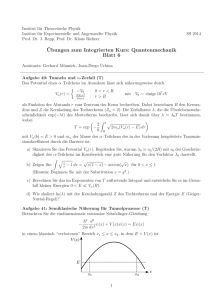
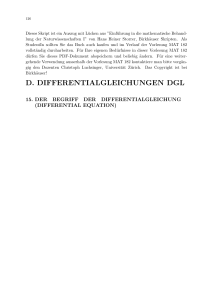
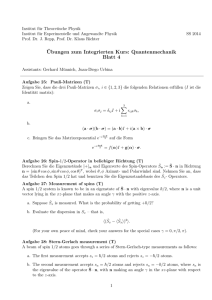
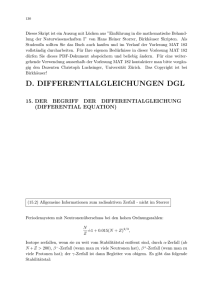
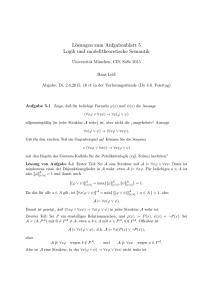
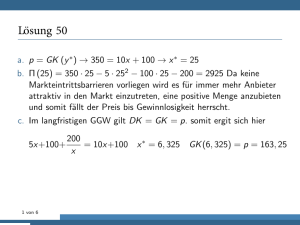
![[g]artenvielfalt in der Green City Frankfurt](http://s1.studylibde.com/store/data/002300504_1-2c3e7c1e2441a055a9b55c89d0ab965e-300x300.png)
